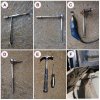I re-caulked the leaky “cheek” seams on my 1992 Exceed this week. Removing the first cheek panel was grueling, taking over 3 hours. The second one, driver’s side, came apart in 40 minutes. The only hard part is the disassembly. I learned from the first one, and I think the second one was just easier. In case it helps you, and referencing the fasteners by number (refer to the MDOCUK photo, earlier post), here are the tactics that worked for me.
Screw #1 and #2 are easy but hard to access in my case because the bull bar prevented a straight-on approach with a screwdriver. Tool “A” below worked for me. That’s a driver bit with a 1/4” wrench around it for leverage, and a 1/4” socket on the back end so I could press hard without cutting up my hand.
Screw #3 is easy, use a normal screwdriver.
Screws #4, #5 and #6 are easy. But I used a socket on an extension, see “B” below to reach #4 which is buried pretty deep.
Screw #7 was hard for me on both sides. I think because the panel and attachment point are somewhat flexible, so you can’t push very hard when trying to loosen the screw. I tried everything on the first panel, and ultimately stripped the seat for the screwdriver. So I used a Dremel tool to cut a slot in the head, and a screwdriver with a very wide tip. And a wrench for leverage. See image “C.” On the second panel I had the same problem, but after a couple of tries decided to go straight to cutting a slot, and removed it pretty easily after that.
Screws #8 and #9 were pretty easy, but I used setup “D” because there isn’t room to get a straight shot with a regular screwdriver.
Screw #10 is easy with a screwdriver or setup “D.”
Screw #11 on the first panel took me about 1.5 hours to crack. I tried everything. Part of the problem is just accessing it from under the rubber. Ultimately I grabbed it with locking pliers and had my wife twist it up out of the way. See “F.” We worried about tearing the rubber, but that didn’t happen. But that first screw wouldn’t budge, so ultimately I cut the head off (Dremel), drilled the stem and removed it with an easy-out. When I replaced it I used a self-tapping screw with a hex head so it can be removed (if ever again) by putting an open-end wrench straight under the rubber (vs. down from the top with a screwdriver which is harder). The other #11 (driver’s side) was much easier. I put a drop of oil on it and let it sit for 10 minutes. Then I deployed the renowned Vessel impact screwdriver – after about 6 whacks I was able to unscrew it. The Vessel didn’t work for me on any of the other screws, but was a champ on this one.
View attachment 2764
Hi there,
Thanks for your advice!
Say, I also have some self tapping screws that are stuck (as Growlerbeanz says, probably havent been good in a previous life).
Tried with wd40, tapping and everything but no movement.
I dont have a dremel tool but i thought of drilling them out, do you think that would be ok as well?
Cheers
Tim


